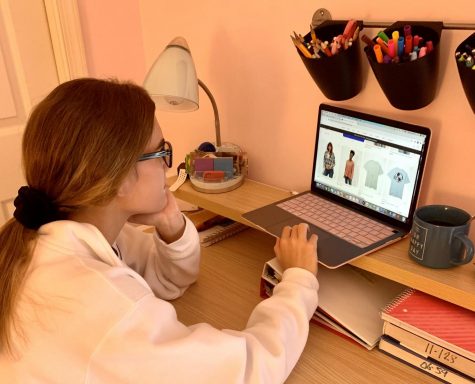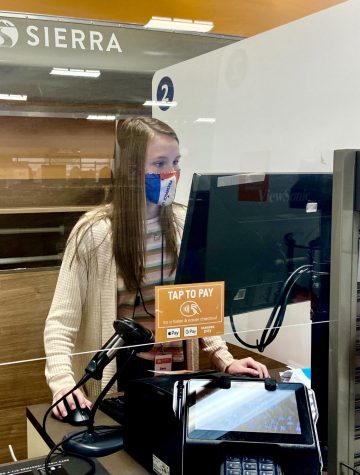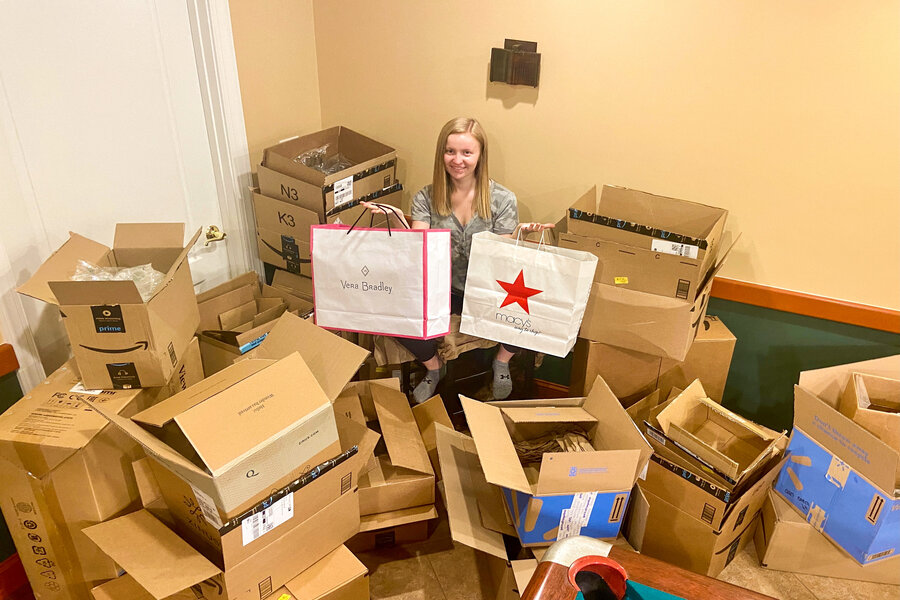Online Shopping: Necessity . . .or therapy?
Evidence of online shopping is the number of brown boxes consumers are collecting and recycling.
October 28, 2020
Have you ever bought something because you loved the advertisement? Maybe you saw the colorful Old Navy jeans commercial and thought you NEEDED to have them to feel bright, cheerful and able to conquer the world (Maybe not with a pink scepter.)
Advertisements often play on emotions and desires to distract consumers and compel them to purchase the product, but have you noticed that you are using online shopping to distract from school work?
In 2019, U.S. companies spent 240.7 billion on advertising, and the numbers keep increasing. Consumers are being manipulated, and we buy what we see.
Business teacher Roger Rich has a degree in marketing and used to own a sign business. He understands that financial decisions, both personal and business, are difficult. Increased shopping means increased risk of scams, identity theft, and poor quality merchandise.
“Make sure that you are using a secure site that you are buying from. Always use a credit card that is protected, too. Although it is easier to buy online, it is also easier for things to get messed up with your purchase,” said Rich.
It is no secret that people often buy out of emotion and seek material goods to replace other missing joys.
Independent Living teacher Leslie Parente teaches lessons about the difference between a need and a want.
“A need is something that is essential or very important. A good example is food or gas for my car. A want is something I would like to have. It’s not necessary and I could live without it. In the beginning of Covid-19, I spent money on needs. As things start to open up, I feel I’m spending more money on wants such as a bike because I want to enjoy my time at home with my to spend more time outside with my family,” said Parente.
Student Spending
You don’t have to be a teacher or an adult to want to spend money. Junior Catherine Bowers has a tutoring job where she tutors English for two hours a day three days a week. She has been in her tutoring position since August all while also participating in virtual learning herself.
“Making money does influence whether I spend more because I can spend and make the money back that I just spent. Now that we are doing virtual learning from home, advertising on social media sites makes me want to buy more clothes. I am home more which is giving me more time to spend on social media in my free time and even during my break periods,” said Bowers.
COVID-19 has moved most to their homes, leading more to watch television, play video games and get distracted with social media–all of which have advertisements.

Senior Elizabeth Rajnik is focusing on school and does not currently have a job.
“I think that not having a job and being at home during virtual learning has actually improved my spending habits. Since I don’t have my own personal income, I’ve always been very wise with my spending. I only buy stuff when I really want or need it. I realize that I don’t need a new fall wardrobe or the coolest new trends that I see in advertisements,” said Rajnik.
Rajnik does, however, enjoy online shopping when she has the money.
“Online shopping is so convenient and easy, especially when you’re signed up for rewards. For example, I’m a part of ClubCali, Hollister’s rewards program. I will get weekly emails letting me know what sales are going on, giving me extra coupons, and letting me know when I’ve spent enough to get extra rewards,” said Rajnik. “I feel that being a part of these programs makes it easier to shop smart. even though they tempt me to buy when I don’t need to be spending money.”
Retail Realities
Senior Carolina Heister works at Target and has seen improvements made to the functions of online shopping and store pick-up processes. She has experienced what she would say is Target forcing more to shop online instead of in-store.
“At Target we have seen a major increase in online orders through shipping and our drive up and pickup services. We are expecting that people will continue to take advantage of these services as it is more convenient than coming in and shopping. Working in retail has impacted my spending habits tremendously. I have always loved shopping and every time people bring things through my line, I want to go looking on the floor for them,” said Heister.
Senior Sierra Rossman works at Sierra Trading Post, where they also have COVID-19 improvements and adjustments with shopping.

“I started working at Sierra during the pandemic, so my interview was over the phone in order to limit contact. We also have a regular cleaner during each shift. We are required to wear a mask during our shifts and have Plexiglas. We also have an online pick up from store option. This allows people to order what they want and not be in the store for long,” said Rossman.
“Virtual school allows me to work more which is a plus, but because I work in retail, I’m tempted to buy more products. I think that if school wasn’t virtual, I would probably spend less because I wouldn’t be able to work in store as much and be exposed to things that I might be tempted to buy,” said Rossman.
Lee Ann Asher, the sister of Math Teacher Mr. Eckard, works part time at HomeGoods. She has worked there for eight years and is a valued member of the Homegoods Team. In addition, Asher has her own business selling sewing kits for small groups, like scouts and life skills classes.
“Everything at HomeGoods was shut down for a while when the pandemic first started because it was simply not essential. This forced customers to purchase from the online website. The website is a very beneficial tool because it also allows us to check prices. I definitely save more during the pandemic. My sewing kit business totally stopped because I sell to schools, so HomeGoods was my main income,” said Asher.
Therapeutic Trends
These consumers are all engaged, at different levels, in retail therapy. A survey done by TNS Global on behalf of Ebates.com found that more than half of Americans (52%), including 64% of women and 40% of men, admit to engaging in “retail therapy”—the act of shopping and spending to improve one’s mood.
“I definitely use shopping as sort of a coping mechanism when I’m stressed or in a bad mood. Often when I feel this way, I get in the car and go shopping to take a breather or a break from the tasks that I have. It’s probably not the best thing for me to do, but it always gets my mind off of stuff that is getting me down,” said Heister.
Junior Marty Ratchford works at Gaver Farm and has extra time between his job and his virtual learning to go shopping–occasionally.
“I do not find shopping in itself very therapeutic, but getting things that I want is always enjoyable to me. I find things that enrich my hobbies, like computer parts, very enjoyable to get because they are things that I care about,” said Ratchford.
Ratchford also believes that the time of the year makes a difference in how enjoyable shopping is.
“The time of the year can matter in terms of how enjoyable it is, especially if it causes a sale. A good example is Black Friday, when there are good deals. I wont pass them up and purchasing during a good deal is more enjoyable. Christmas is also always a fun time to shop. Stores are often decorated along with the deals they have. So not only do you get a good deal, you also get to enjoy the holiday scenery,” said Ratchford.




